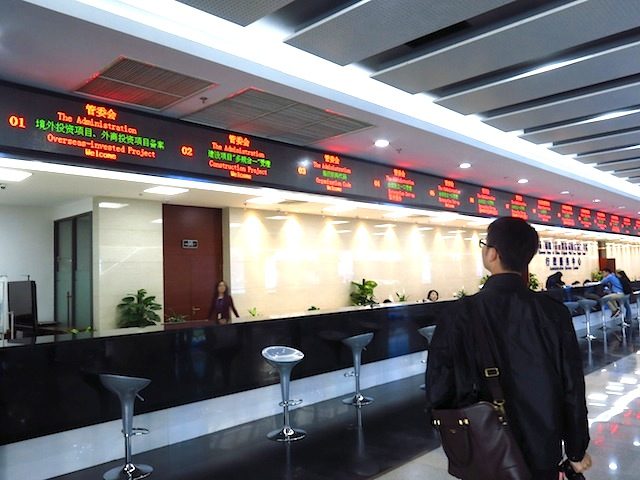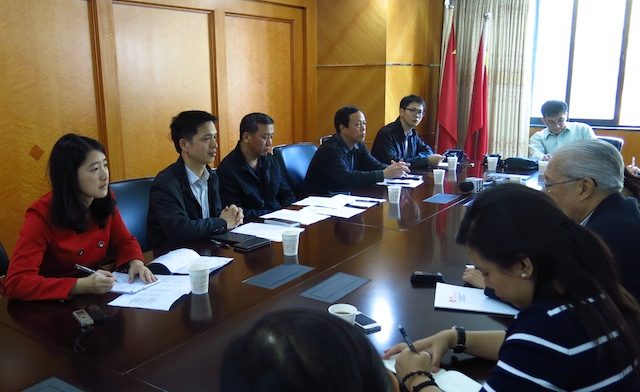SUMMARY
This is AI generated summarization, which may have errors. For context, always refer to the full article.

QUANZHOU, China – The territorial claims of their central government notwithstanding, two cities in Fujian province have included the Philippines among priority countries of cooperation under a national strategy packaged as an economic diplomacy initiative.
Xiamen and Quanzhou officials revealed their respective plans in separate meetings with the Philippine media and academics who joined the 21st Century Maritime Silk Road tour in Fujian province from April 13 to 18, organized by the Chinese Embassy in Manila.
“Xiamen is a coastal city while the Philippines is an island country. We believe we have a lot of cooperation potential,” said Chen Jianjin, vice senior officer of the Xiamen Commerce Bureau.
In a presentation at the Xiamen Commerce Bureau office, Chen said his agency listed 9 priority countries for cooperation in its proposed action plan under China’s Belt and Road initiative – the Philippines, Malaysia, Thailand, Vietnam, Singapore, Indonesia, India, Iran, and Sri Lanka.
“Under our initiative, we have a total of 39 important projects, 9 directly connected to the Philippines… They are mainly for infrastructure construction to improve connectivity between our two sides,” Chen said.
He cited as an example the planned Southeast China International Shipping Center where an international container port will be built.
Chen also said that the cruise home port project will seek to attract international cruise ships to Xiamen, with stops along the maritime silk road, and that a new airport will be built.
Increased trade
Chen said there are 199 Philippine enterprises in Xiamen with a total capital of $280 million, making the Philippines the 10th largest investor in the city.
The Philippine enterprises are mostly in the manufacturing industry (textile, electronics, and paper) and the services industry (recreation, real estate, and warehousing).
Among the bigger Philippine enterprises in Xiamen are the SM Group, the Robinsons Group, and Asia Brewery Ltd, while the others are mostly medium and small in size.

Xiamen businessmen only have 4 enterprises in the Philippines with total committed investments of $3.16 million in the mining industry.
Two-way trade between Xiamen and the Philippines reached $2.69 billion in 2014, or 23.9% of total trade between the Association of Southeast Asian Nations (ASEAN) and Xiamen.
2nd largest trading partner
Among ASEAN members, the Philippines is the second biggest trading partner of Xiamen.
Chen said that Xiamen has had a “rapid” growth of imports from the Philippines, increasing by 16% to $840 million in 2014. The Philippine products include nickel, electronic products, and agricultural products.
“In the future we plan to give greater support for importing goods from the Philippines and other ASEAN countries – consumption goods. We will give more support for these products,” he said.
The commerce official also said that Xiamen has been urging its local enterprises to go global and invest overseas, particularly in “new business forms like cross-border financing and cross-border leasing.”
“A lot of Philippine-Chinese are coming from Xiamen and we have maintained very good relations with the overseas Chinese organizations and chambers of commerce so we hope under this One Belt One Road initiative, we can further strengthen and deepen our cooperation,” Chen said.
Dai Le Shen, Xiamen Commerce Bureau Division Director for Development and Planning, said that investors are drawn to Xiamen for its good air quality, and its efficient government services, among others.
“Based on our natural environment and advantages, we are now attracting and selecting foreign capital to Xiamen. We are selecting those businesses compatible and suitable for Xiamen’s environment,” Dai added.
Xiamen allows only electric motorcycles and has placed a cap on public bus emissions.
Pioneer
Beijing has named Fujian province as the core area of the 21st Century Maritime Silk Road, a major component of its Belt and Road initiative, which has been allotted a $40-billion fund.

The Belt and Road strategy is anchored on what China calls the “Silk Road Spirit” – the spirit of “peace and cooperation, openness and inclusiveness, mutual learning and mutual benefit” that marked the ancient Silk Road spanning Asia, Europe, and Africa more than 2,000 years ago – but with an emphasis on deeper financial cooperation.
Quanzhou, the starting point of the ancient maritime silk road, is taking advantage of the fresh opportunity, said city officials.
Chen Jin Shen, Section Chief of the Quanzhou Municipal Bureau of Commerce, said that the ASEAN is an important area where Quanzhou would pursue Maritime Silk Road cooperation projects.
“The Philippines is also one of the most important countries in the ASEAN. We’re sure that there will be some projects related to the Philippines in Quanzhou,” he said, responding to questions.
Chen also said that business and people-to-people exchanges between Quanzhou and the Philippines will be enhanced by the start of direct Philippine Airlines flights between Manila and Jinjiang, a county in Quanzhou, this week.
Chen said that about 90% of businesses in Quanzhou are private businesses, and that the main industries are garments and footwear, building materials, petrochemicals, and machinery with a combined annual output of about 100 billion yuan ($16.1 billion).

The Philippines is the third biggest source of foreign direct investments of Quanzhou, after Hong Kong and Taiwan.
Annual Quanzhou exports to the Philippines are at $1 billion, while its Philippine imports only amounted to $60 million, Chen said.
“There is some room for our closer cooperation,” he said.
Helen Chen, Associate Consultant of the Quanzhou Municipal Foreign Affairs and Overseas Chinese Affairs Office, said that Quanzhou wants to become a “pioneer” in the initiative through a proposed action plan that would involve about 180 projects.
“We want to use this to encourage our businessmen who have great potentials to make investments in the countries in Southeast Asia and also they can establish their companies in some industrial parks in those countries,” Chen said.
The local action plans are subject to central government approval.
There are over 13,000 foreign enterprises in Quanzhou, with total investments of $34.5 billion. – Rappler.com
$1 = 6.1 yuan
Add a comment
How does this make you feel?
There are no comments yet. Add your comment to start the conversation.